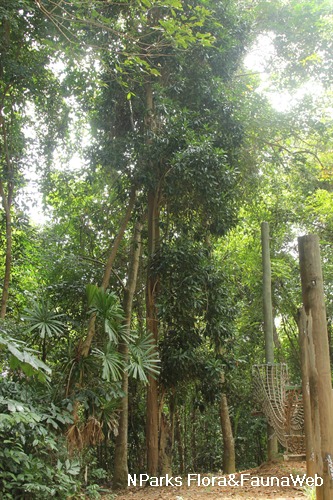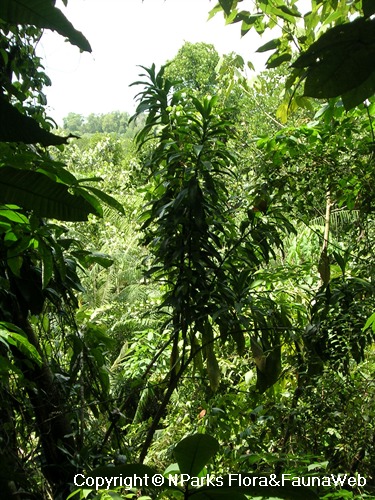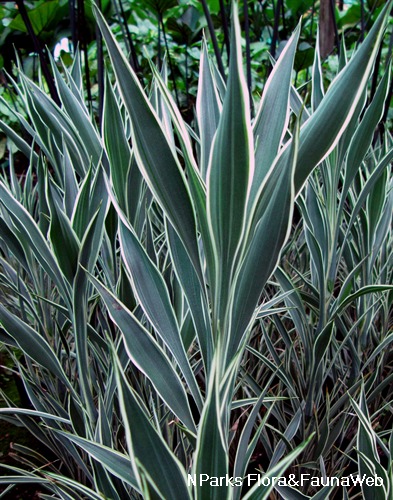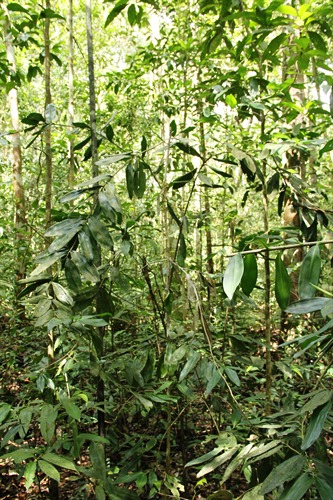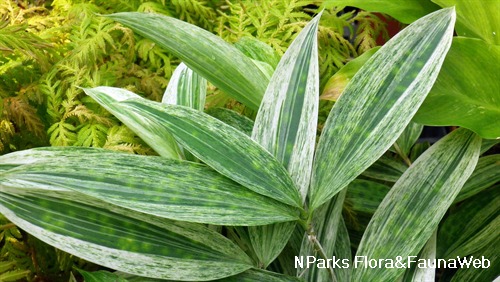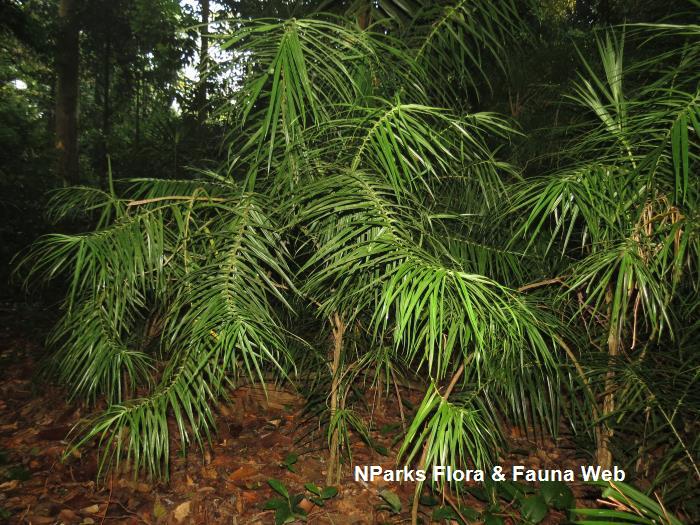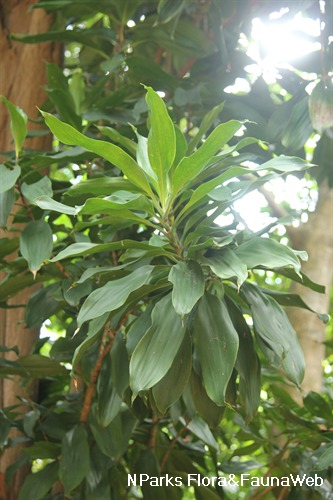
Back
Dracaena maingayi Hook.f.
| Family Name: | Asparagaceae |
| Synonyms: | Pleomele maingayi (Hook.f.) N.E.Br. |
| Common Name: | Maingay's Dracaena |
Name
Classifications and Characteristics
| Plant Division | Angiosperms (Flowering Seed Plants) (Monocotyledon) |
|---|---|
| Plant Growth Form | Tree (Medium (16m-30m)) |
| Lifespan (in Singapore) | Perennial |
| Mode of Nutrition | Autotrophic |
| Plant Shape | Irregular |
| Maximum Height | 20 m |
Biogeography
| Native Distribution | Peninsular Malaysia & Singapore |
|---|---|
| Native Habitat | Terrestrial (Primary Rainforest, Coastal Forest, Freshwater Swamp Forest) |
| Preferred Climate Zone | Tropical |
| Local Conservation Status | Native to Singapore (Endangered (EN)) |
Description and Ethnobotany
| Growth Form | It is a tree that can grow up to 20 m tall. |
|---|---|
| Foliage | Its stalked leaves have leathery leaf blades that are lance-shaped-oblong, narrowing to a slender tip, dark green, and 25–30 by 7.6 cm. |
| Flowers | Its light yellow, tubular flowers are 2.5 cm long, borne on a stalked inflorescence. |
| Fruit | Its fleshy fruits are round, orange, and 2.5 cm in diameter. |
| Habitat | It grows in coastal forests and swamp forests. It occurs locally in Bukit Kallang, Nee Soon Swamp Forest, Pulau Pawai, Pulau Tekong, Pulau Ubin, and Sentosa Island. |
| Associated Fauna | Its flowers are insect-pollinated. The fruits are probably eaten by small mammals or birds. |
| Cultivation | It can be propagated from seed or stem cutting. |
| Etymology | Greek Dracaena, a female dragon, referring to dragon tree; Latin maingayi, commemorating A. C. Maingay, a 19th century doctor and botanist of the East India Company |
| Ethnobotanical Uses | Cultural / Religious: Heritage Tree There is currently one individual of Dracaena maingayi listed as a Heritage Tree in Singapore. It can be found at Sentosa. To find out more about these trees, please visit the Heritage Tree Register. |
Landscaping Features
| Landscaping | It has attractive foliage, and is suitable to be planted in coastal areas as it can tolerate hot, sunny, high wind speed, and frequent salt spray condition. It can also be planted along streetscape and parks. |
|---|---|
| Desirable Plant Features | Ornamental Foliage |
| Landscape Uses | General, Suitable for Roadsides, Parks & Gardens, Small Gardens, Coastal |
Fauna, Pollination and Dispersal
| Pollination Method(s) | Biotic (Fauna) |
|---|---|
| Seed or Spore Dispersal | Biotic (Fauna) |
Plant Care and Propagation
| Light Preference | Semi-Shade, Full Sun |
|---|---|
| Water Preference | Moderate Water |
| Plant Growth Rate | Moderate |
| Rootzone Tolerance | Moist Soils, Well-Drained Soils, Fertile Loamy Soils |
| Maintenance Requirements | Low |
| Propagation Method | Seed, Stem Cutting |
Foliar
| Foliage Retention | Evergreen |
|---|---|
| Mature Foliage Colour(s) | Green |
| Mature Foliage Texture(s) | Leathery |
| Foliar Type | Simple / Unifoliate |
| Foliar Arrangement Along Stem | Rosulate / Rosette |
| Foliar Attachment to Stem | Petiolate |
| Foliar Shape(s) | Non-Palm Foliage (Lanceolate, Oblong) |
| Foliar Venation | Parallel |
| Foliar Margin | Entire |
| Leaf Area Index (LAI) for Green Plot Ratio | 3.0 (Tree - Intermediate Canopy) |
Floral (Angiosperm)
| Flower & Plant Sexuality | Bisexual Flowers |
| Flower Colour(s) | Cream / Off-White |
|---|---|
| Flower Grouping | Cluster / Inflorescence |
Fruit, Seed and Spore
| Mature Fruit Colour(s) | Orange |
|---|---|
| Fruit Classification | Simple Fruit |
| Fruit Type | Fleshy Fruit , Non-Accessory Fruit |
Image Repository
Others
| Master ID | 1568 |
|---|---|
| Species ID | 2861 |
| Flora Disclaimer | The information in this website has been compiled from reliable sources, such as reference works on medicinal plants. It is not a substitute for medical advice or treatment and NParks does not purport to provide any medical advice. Readers should always consult his/her physician before using or consuming a plant for medicinal purposes. |

